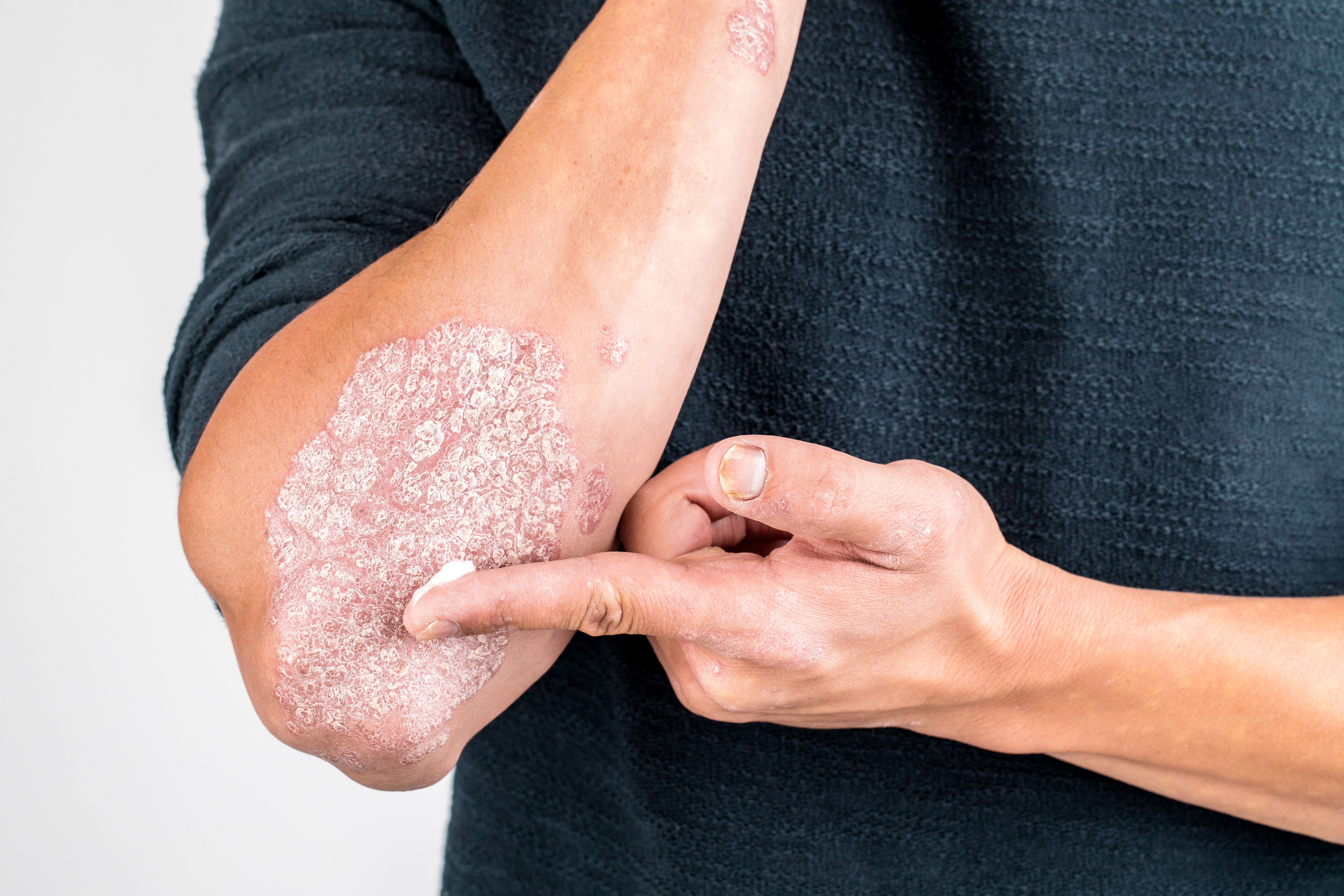- Case-Based Roundtable
- General Dermatology
- Eczema
- Chronic Hand Eczema
- Alopecia
- Aesthetics
- Vitiligo
- COVID-19
- Actinic Keratosis
- Precision Medicine and Biologics
- Rare Disease
- Wound Care
- Rosacea
- Psoriasis
- Psoriatic Arthritis
- Atopic Dermatitis
- Melasma
- NP and PA
- Skin Cancer
- Hidradenitis Suppurativa
- Drug Watch
- Pigmentary Disorders
- Acne
- Pediatric Dermatology
- Practice Management
- Prurigo Nodularis
- Buy-and-Bill
Article
Understanding, diagnosing pediatric psoriasis phenotypes
Author(s):
A pediatric dermatologist addresses important differences in children with psoriasis, versus adults.
Pediatric psoriasis shares some but not all features of adult psoriasis. Being familiar with the disease’s impact on children helps dermatologists optimize a growing therapeutic armamentarium, including biologics that were FDA approved in the last year for children with chronic moderate-to-severe plaque psoriasis.
Psoriasis is thought to affect about 2.6 percent of the U.S. population. First outbreaks usually appear between ages 15 and 35; however, about 20,000 children under 10 years of age are diagnosed with the skin disease each year, according to the National Psoriasis Foundation.
That’s probably an underestimate, according Elaine C. Siegfried, M.D., professor of pediatrics and dermatology at Saint Louis University Cardinal Glennon Children's Hospital, in St. Louis.

Dr. Siegfried
“I think psoriasis is under-recognized in children. And one of the reasons is that some of the clinical features are different than those of adult psoriasis,” she said.
Psoriasis is easy to diagnose in children who present with classic, sharply circumscribed plaques with silvery scale on the trunk and extremities.
“But many children with psoriasis present with involvement limited to the face and diaper area, or skin lesions that are not as scaly or indurated as those typically seen in adults,” Dr. Siegfried said.
Another challenge with diagnosing pediatric psoriasis is a related condition that some call “psoriasis-eczema overlap,” characterized by ambiguous lesions with features of both psoriasis and eczema. Other descriptive names for the condition are nummular eczema, psoriasiform dermatitis and PsEma.
“Overlap is actually quite common. I think it’s more common than classic psoriasis in children, but there is no clinical, histologic or laboratory biomarker to distinguish it from psoriasis or eczema or establish it as a mix of both” Dr. Siegfried says. “So, it’s a controversial diagnosis.”
The lesions of overlap are well-circumscribed and nummular, but without coarse silvery scale. These children also often have scalp, posterior auricular and palmoplantar involvement, as well as nail pits, ichthyosis vulgaris and atopic comorbidities, she said.
Distinguishing overlap from other forms of eczema is important because it’s relevant to prognosis and treatment-especially biologic treatment when the skin condition is severe, according to the dermatologist. And unlike eczema, which tends to wane with age, pediatric psoriasis has a less predictable course, with or without periods of remission, she said.
“Making a diagnosis of overlap requires a careful exam for all the clues,” she says. “The posterior auricular scale and nail changes in young children and infants can be subtle and are easily overlooked.”
Another psoriasis variant that occurs in children and adults is paradoxic psoriasis, which can be triggered by drugs that are used to treat psoriasis.
“Psoriasis is not just one disease; it’s a phenotype with different subtypes,” Dr. Siegfried says.
NEXT: LOCATION
In infants, psoriasis commonly involves the face and diaper area.
“That makes sense in because these are the sites subjected to Koebnerization from frequent wiping. For adults, the elbows and knees get the most frictional abuse,” Dr. Siegfried says.
Other areas of predilection in young children are the thumb (if they’re thumb-suckers) and scalp, often recognized as cradle cap in infants.
Besides the major trigger of low-grade skin trauma, psoriasis in children also can have a microbial trigger. The most recognized, according to Dr. Siegfried, is acute-onset, small plaque psoriasis associated with streptococcal (group A Strep) colonization or infection, called guttate psoriasis.
OPTIMAL TREATMENT
Dermatologists should consider using antibiotics to treat children with guttate psoriasis, who have confirmed evidence of streptococcus. In some cases, oral antibiotic treatment will result in a long-term remission. If children carry streptococcus, the psoriasis may quickly relapse after the antibiotics are discontinued. An option for carriers is to remove the tonsils, which reduces the microbial load and can result in at least temporary remission, Dr. Siegfried says.
First-line treatment of pediatric psoriasis is often a corticosteroid, but unlike eczema, topical monotherapy is less effective than combination treatment, and more often results in rebound after corticosteroid discontinuation.
“It is safest to limit long-term use of a topical corticosteroid to less than once daily, especially in young infants and children, because frequent application increases the risk of barrier weakening and percutaneous absorption,” she says.
A more effective treatment is a corticosteroid topical plus a corticosteroid-sparing agent, (topical calcineurin inhibitor or vitamin D analog). One option that combines medications is Taclonex (calcipotriene and betamethasone diproprionate, Leo) topical suspension for plaque psoriasis, which is the only FDA approved option for treating psoriasis in children, labelled for use on the scalp of adolescents, aged 12 to 17.
Dr. Siegfried frequently prescribes Taclonex. The ointment formulation is now available as a generic product, but even that is expensive. Insurance access is often restricted as off-label for children and when covered, even just the necessary copay is out of reach for many families, she says.
As patients get better on the combination, dermatologists should consider using a potent topical corticosteroid and vitamin D analog separately, to minimize the corticosteroid exposure.
For families who don’t have access to corticosteroid-sparing topical calcineurin inhibitors or vitamin D analogs, Dr. Siegfried says there’s the option of coal tar, although it has a strong odor and stains fabric, and there is concern about carcinogenicity.
The next line of treatment is phototherapy, which works well but is too difficult and time-consuming for most families.
“In-office phototherapy requires three-times-a-week visits for at least three to six months, and then twice a week, which is not practical for most busy families. There are other special challenges in delivering phototherapy to children. Some can’t resist removing their goggles to get a look at the bulbs, followed by retinal burns,” she says.
That brings dermatologists to systemic options for moderate to severe psoriasis. In November 2016, etanercept (Enbrel/ Amgen) was the first biologic approved by the FDA for chronic moderate-to-severe psoriasis patients, ages four to 17 years. It is a tumor necrosis factor (TNF) receptor antagonist, which is also approved for adults with psoriatic arthritis. This agent has the most safety data in children, including well over a decade of prospective registry data for monotherapy and combination treatment with methotrexate for juvenile idiopathic arthritis.
NEXT: USTEKINUMAB FDA APPROVAL
Ustekinumab (Stelara/Janssen Pharmaceutical) was FDA approved in October 2017 for moderate-to-severe plaque psoriasis in adolescents ages 12 years and older, who are candidates for phototherapy or systemic therapy. Adalimumab (Humira, AbbVie) is another TNF-blocker that has been extensively studied in children, and approved to age 4 in Europe for pediatric psoriasis and in the U.S. to age 6 for Crohns disease and age 2 for juvenile idiopathic arthritis, but lacks specific FDA labelling for pediatric psoriasis, according to Dr. Siegfried.
The safety and efficacy of a few other biologic agents and a small molecule PDE4 inhibitor are currently in clinical trials for pediatric psoriasis down to age 6, she says.
Pediatric psoriasis patients are good candidates for systemic therapy if they have a minimum of 10 percent body surface area involvement, or if their psoriasis is in places that are otherwise hard to treat, including skin folds, scalp or palms and soles.
“Nail psoriasis is another special area. And nail psoriasis can be very severe and debilitating in some children,” she says.
Dr. Siegfried’s first choice for systemic treatment for severe psoriasis in children is methotrexate. She says that 80% of children in a retrospective review of her patients with psoriasis on methotrexate respond well after three months.
“The problem with methotrexate is that it’s a really old drug, so we have less well-established guidelines about optimal dosing. Retrospective analysis has identified obesity and alcohol consumption as the major risk factors for methotrexate-associated hepatic fibrosis in adults. Like adults, obesity is more common in children with psoriasis, but not to the same degree,” Dr. Siegfried said.
“But optimal methotrexate use is tricky. The devil is in the details when managing children in terms of dosing, formulation, route of administration, and helping patients tolerate the drug,” Dr. Siegfried said.
Weighing the risks of methotrexate becomes more important when the lifetime cumulative dose is higher than 2 to 3 grams.
TNF receptor blockers can improve psoriasis, while triggering atopy, including eczema and other atopic comorbidities.
“This is why it is important to identify overlap. I first recognized the condition after treating a child with an anti-TNF agent for chronic inflammatory skin disease that gradually evolved to include recalcitrant palmoplantar involvement. His palms and soles cleared, but his itch and antecubital and popliteal skin lesions flared. Others cases of similar atopic adverse effects have been published,” she says.
There isn’t much data to support her suspicion, but Dr. Siegfried says blocking other inflammatory pathways, such as interleukin-12/23 with the biologic agent ustekinumab, might work for both eczema and psoriasis. Methotrexate seems to work for both.
Biologic dosing in children is weight-based, and regimens differ. Stelara requires an injection every three months while Enbrel is dosed once a week. There’s a lot to consider when choosing the best medication for an individual patient.
For example, Dr. Siegfried has a severely autistic, 300-pound 12-year-old patient with psoriasis. She prescribed Stelara.
“He had thick plaques and severe tactile aversion that restricted practical use of topicals, plus, we wanted to avoid TNF blockers because they can cause weight gain. He has been on ustekinumab for three years and is doing fabulously. It was a miracle treatment for the family," she said.
NEXT: TREATMENT HURDLES
There are few FDA-approved psoriasis treatments for children. “So, access to treatment is often a challenge. And treatment with topical corticosteroid monotherapy is just sub-optimal,” she says.
Insurance carriers can deny coverage for expensive psoriasis medications that don’t have pediatric labeling. Even when the drugs are covered, out-of-pocket expenses can be too much for families.
There is a lack of long-term safety data that follow children with psoriasis on systemic medications. And, there is only one published head-to-head efficacy study. This small 16-week trial, conducted in Canada and Europe, found a only a small trend in greater efficacy of the higher parenteral dose (0.8 mg/kg every other week) of adalimumab compared to a relatively low oral dose of methotrexate (0·1-0·4 mg/kg per week) in children over age 4, Dr. Siegfried said.
“In moving forward, it would really be wonderful to have more robust clinical trials with active comparator rather than placebo controls, but this is only feasible when both drugs are FDA-approved,” she said.
DISCLOSURES
Dr. Siegfried is a principal investigator for Allergan, Amgen, Eli Lilly and Company, Mayne Pharma Group, Pierre Fabre Dermo-Cosmetique US and Regeneron. She is on the advisory board of Pfizer and Verrica Pharmaceuticals, is a consultant to Valeant Pharmaceuticals North America, and is on the Data Safety Monitoring Board of GlaxoSmithKline.






